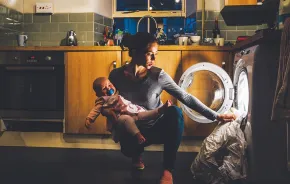
A professor at the University of Washington’s College of Education, Katie Headrick Taylor studies children’s digital literacy practices, spatial literacy as it pertains to youth mobility and mapping, new ways of teaching spatial literacies and how to leverage new technologies to engage young people in civic processes that drive community change. Taylor earned her bachelor’s degree from New York University and her doctorate from Vanderbilt University. She came to the UW from Northwestern University, where she studied how children use visual media. She’s originally from Tennessee (“not urban!” she says) and is a mom of two young kids.
When did your interest in technology begin?
My dad was tech geek — he was one of the first people in my neighborhood to get Internet; we had AOL dial-up. I was always a tech nerd.
Later, I worked as an educator at a homeless shelter in Nashville. That work really made me think about how it is that we can get kids who are “nontraditional learners” to engage in learning in all kinds of settings; so, helping kids get out into the community and see that learning was all around them. That really ignited my interest in using technology to bridge learning spaces.
What’s the focus of your work?
I have two big projects.
First, I am pitching an idea to the National Science Foundation Cyberlearning [and Future Learning Technologies] directorate. They have a call to fund projects using technology in a state-of-the-art kind of way. At Vanderbilt, I did a project on getting kids to collect data on their own daily lives using wearable GPS. These were kids living in mobility deserts, places not conducive for getting around as a pedestrian or on a bicycle. I was hoping to share that data with community and urban planners. So these kids were involved in building bikes and then riding them around the neighborhood, but they quickly found that it wasn’t safe to ride around the neighborhood. So I came into that existing project, helped them collect data and then built their own counter-maps. Then they shared the maps with urban planners and local stakeholders, and we actually saw some of their recommendations come to fruition.
So I’m trying to get more support to do that work in Seattle. Kids have a unique perspective to offer to these community development processes, conversations kids aren’t usually involved in. And kids like technology a lot, and they want to and need to get around. It’s a nice combination of interests. I’m hoping to partner with Cascade Bicycle Club in South Seattle. I’m pitching the proposal in December and already getting a team together.
The other project is to follow some teachers in Seattle public schools (to start, I am working with Highline School District), doing ethnographic, on-the-ground work to see what practices teachers are using to integrate technology. And then I want to follow kids into their homes to see if they are following the teacher’s practices in their homes, and if not, ask how can we bridge that gap.
What’s the parents’ role with regard to screen time? Or what should it be?
We’ve seen some really cool things parents do with technology with their kids. We’ve seen a mom introduce an iPhone app into her daughters’ piano practice, to help the girls practice their rhythm. Parents are really good about finding videos on YouTube to help their kids cook, or to
help find historical information. We saw a kid who played the cello, and he heard older kids playing [Led Zeppelin’s] “Kashmir” in the orchestra, and he asked his mom what it was, and his mom took him on YouTube and they listened to old Zeppelin videos, and they had a rich convergence of interests, where mom listened to Zeppelin like she used to and the kid was engaged.
Kids often want you to sit down and play a game with them, or watch with them. We too often talk about “Is the device babysitting my kid?” But instead, it’s that the device is giving us the opportunity to engage in our kids’ interests with them.
What’s your favorite way of engaging with technology with your own kids?
I have a 3-and-a-half-year-old and a 9-month-old. The 9-month-old is doing other stuff. But my 3–and-a-half-year-old loves Toca Town and that whole line of games. He’s also big into PBS Kids on the iPad. We do a lot of watching Netflix kids’ channels. We limit iPad time to when you can’t go outside.
He’s always trying to take selfies and pick videos off my phone. I have built-in research subjects with my kids, and it’s crazy and fun. It’s interesting to see how it is that they follow digital media. Their engagement with tech is always changing, not only because the tech is changing, but because they are developing into different people. It makes technology a very powerful thing.
I know I sound very hip hip hooray about technology, and I am, but we try to make it a balanced thing. We really value being outside. IPad things are for after dinner.











